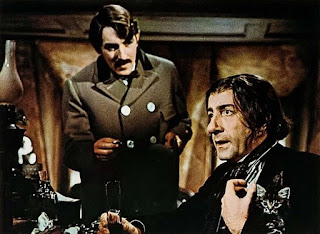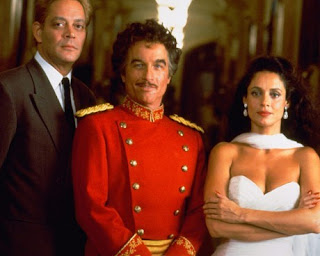 Watchingwell
Watchingwell
Curated classic films
Happy New Year …
 Holiday (1938). Directed by George Cukor, Katherine Hepburn
plays a free soul trapped in a stuffy society family, but remains loyal to her
siblings, a weak, unhappy brother, played by Lew Ayres and a shallow, self-satisfied
sister, played by Doris Nolan. When
sister gets engaged to another free spirit (How this happens, we are puzzled to
imagine, except that he is played by Cary Grant.), Hepburn’s character, Linda,
tries to throw her an engagement party on New Year’s Eve. But Daddy intervenes
and makes it a social event and Linda is very unhappy. Guess how it ends.
Holiday (1938). Directed by George Cukor, Katherine Hepburn
plays a free soul trapped in a stuffy society family, but remains loyal to her
siblings, a weak, unhappy brother, played by Lew Ayres and a shallow, self-satisfied
sister, played by Doris Nolan. When
sister gets engaged to another free spirit (How this happens, we are puzzled to
imagine, except that he is played by Cary Grant.), Hepburn’s character, Linda,
tries to throw her an engagement party on New Year’s Eve. But Daddy intervenes
and makes it a social event and Linda is very unhappy. Guess how it ends.
 Holiday Inn (1942). Directed by Mark Sandrich, Bing Crosby and his
partner, Fred Astaire, open a country inn and entertain there on all the
holidays, courtesy of the appropriate Irving Berlin songs, including “Let’s
Start the New Year Right”, for New Year’s Eve. With the help of lovely Marjorie
Reynolds, the inn is a big hit. But when
Fred wants to steal her and head out to Hollywood, Bing tries to secretly thwart
the plan, which Marjorie resents. Bing spends the rest of the holidays at the
inn alone and miserable.
Holiday Inn (1942). Directed by Mark Sandrich, Bing Crosby and his
partner, Fred Astaire, open a country inn and entertain there on all the
holidays, courtesy of the appropriate Irving Berlin songs, including “Let’s
Start the New Year Right”, for New Year’s Eve. With the help of lovely Marjorie
Reynolds, the inn is a big hit. But when
Fred wants to steal her and head out to Hollywood, Bing tries to secretly thwart
the plan, which Marjorie resents. Bing spends the rest of the holidays at the
inn alone and miserable.
 I’ll Be Seeing You (1944) Directed
by William Dieterle and an uncredited George Cukor. Similar kind of story as soldier,
Joseph Cotten, is befriended by Ginger Rogers when he is alone during the
holidays. Another bittersweet New Year’s Eve dance as Ginger is facing jail
time when she returns after the holiday furlough. And they also fall in love. Nice
family drama with Spring Byington, Tom Tully and Shirley Temple rounding out
the cast.
I’ll Be Seeing You (1944) Directed
by William Dieterle and an uncredited George Cukor. Similar kind of story as soldier,
Joseph Cotten, is befriended by Ginger Rogers when he is alone during the
holidays. Another bittersweet New Year’s Eve dance as Ginger is facing jail
time when she returns after the holiday furlough. And they also fall in love. Nice
family drama with Spring Byington, Tom Tully and Shirley Temple rounding out
the cast.

 But the award for the worst movie New Year’s Eve experience goes
to Fredo Corleone in The Godfather Part II (1974) when
brother, Michael gives him the kiss of death (literally) instead of wishing him
a Happy New Year. And we all know why, having seen this 496 times. Directed by Francis Ford Coppola.
But the award for the worst movie New Year’s Eve experience goes
to Fredo Corleone in The Godfather Part II (1974) when
brother, Michael gives him the kiss of death (literally) instead of wishing him
a Happy New Year. And we all know why, having seen this 496 times. Directed by Francis Ford Coppola.
it could be worse.
So did you ever think, why is everybody so happy on New
Year’s Eve, celebrating another year when it just means that we’re another year
closer to death? Oh, sorry, that’s just
me.
However, it does remind me that there have been some New
Year’s Eve celebrations in movies that were more notable for misery than joy
and while everyone is throwing streamers and singing Auld Lang Syne, at least one of the main characters is singing an
entirely different tune. And that should
give you good reason to celebrate because you’re not in one of these
unfortunate situations.
After the Thin Man (1936), directed by W.S. Van Dyke, the
second in the series, after the first, very successful, comedy/mystery
adventure of Nick and Nora Charles, this sequel is a little darker and not as
funny. But it features a very young James Stewart playing the rejected suitor
of Nora’s unhappily married cousin, whose husband has disappeared. Nick and Nora spend New Year’s Eve trying to
find him at his last known hangout, “The Lychee Club”.
 Holiday (1938). Directed by George Cukor, Katherine Hepburn
plays a free soul trapped in a stuffy society family, but remains loyal to her
siblings, a weak, unhappy brother, played by Lew Ayres and a shallow, self-satisfied
sister, played by Doris Nolan. When
sister gets engaged to another free spirit (How this happens, we are puzzled to
imagine, except that he is played by Cary Grant.), Hepburn’s character, Linda,
tries to throw her an engagement party on New Year’s Eve. But Daddy intervenes
and makes it a social event and Linda is very unhappy. Guess how it ends.
Holiday (1938). Directed by George Cukor, Katherine Hepburn
plays a free soul trapped in a stuffy society family, but remains loyal to her
siblings, a weak, unhappy brother, played by Lew Ayres and a shallow, self-satisfied
sister, played by Doris Nolan. When
sister gets engaged to another free spirit (How this happens, we are puzzled to
imagine, except that he is played by Cary Grant.), Hepburn’s character, Linda,
tries to throw her an engagement party on New Year’s Eve. But Daddy intervenes
and makes it a social event and Linda is very unhappy. Guess how it ends.
Bachelor Mother (1939), directed by Garson Kanin and starring
Ginger Rogers as – what else – a kind-hearted, working girl, who finds a baby
outside a foundling home and tries to bring it inside, and then, as it happens only
in the movies, nobody believes that the baby is not hers. We, the audience,
believe that we could extricate ourselves from this predicament even in 1939,
by involving the legal system. However,
then there wouldn’t be a movie. Ginger’s employer, or to be exact, the
employer’s son, played by David Niven, gets involved and makes it even more
difficult for her. Fast forward: they go
out for New Year’s Eve while he still believes that she’s the mother. (Remade sadly in 1956 as Bundle of Joy with Debbie
Reynolds and Eddie Fisher.)
 Holiday Inn (1942). Directed by Mark Sandrich, Bing Crosby and his
partner, Fred Astaire, open a country inn and entertain there on all the
holidays, courtesy of the appropriate Irving Berlin songs, including “Let’s
Start the New Year Right”, for New Year’s Eve. With the help of lovely Marjorie
Reynolds, the inn is a big hit. But when
Fred wants to steal her and head out to Hollywood, Bing tries to secretly thwart
the plan, which Marjorie resents. Bing spends the rest of the holidays at the
inn alone and miserable.
Holiday Inn (1942). Directed by Mark Sandrich, Bing Crosby and his
partner, Fred Astaire, open a country inn and entertain there on all the
holidays, courtesy of the appropriate Irving Berlin songs, including “Let’s
Start the New Year Right”, for New Year’s Eve. With the help of lovely Marjorie
Reynolds, the inn is a big hit. But when
Fred wants to steal her and head out to Hollywood, Bing tries to secretly thwart
the plan, which Marjorie resents. Bing spends the rest of the holidays at the
inn alone and miserable.
Remember the Night (1940). Directed
by Mitchell Leisen. Barbara Stanwyck is
befriended by district attorney, Fred MacMurray, back home in Indiana for the
holidays. Bittersweet New Year’s Eve
dance as Stanwyck is facing jail time when she returns to New York, at the same
time she is falling in love with Fred.
And vice versa. This year the
film has moved up to my number two holiday film (number one being The
Cheaters from 1945, as all you loyal readers know).
 I’ll Be Seeing You (1944) Directed
by William Dieterle and an uncredited George Cukor. Similar kind of story as soldier,
Joseph Cotten, is befriended by Ginger Rogers when he is alone during the
holidays. Another bittersweet New Year’s Eve dance as Ginger is facing jail
time when she returns after the holiday furlough. And they also fall in love. Nice
family drama with Spring Byington, Tom Tully and Shirley Temple rounding out
the cast.
I’ll Be Seeing You (1944) Directed
by William Dieterle and an uncredited George Cukor. Similar kind of story as soldier,
Joseph Cotten, is befriended by Ginger Rogers when he is alone during the
holidays. Another bittersweet New Year’s Eve dance as Ginger is facing jail
time when she returns after the holiday furlough. And they also fall in love. Nice
family drama with Spring Byington, Tom Tully and Shirley Temple rounding out
the cast.
One-Way Passage (1932). Directed by Tay Garnett. William Powell is a murderer being returned
to face the gallows on a ship crossing the Pacific where he meets Kay Francis,
an heiress who is dying and is having one last adventure. When the detective
repays Powell’s character for saving his life by allowing him the freedom of
the ship, the romance takes shape and the couple vow to meet in Agua Caliente
on New Year’s Eve. But of course, they never make it.
Till We Meet Again (1940) Directed by Edmund Gouldin, Merle
Oberon and George Brent reprise the Francis/Powell roles in this faithful remake
and do respectable work as the doomed pair who fall in love on the ship that is
taking him to the gas chamber.

Show Boat (1936). Directed by James Whale, starring Irene Dunne
and Alan Jones, remade in 1951 with Kathryn Grayson and Howard Keel, and directed
by George Sidney. In both versions of the Oscar Hammerstein II and Jerome Kern
musical, a New Year’s Eve celebration is a sad occasion until Magnolia’s reunion
with her estranged parents, strangely, with the background of “After the Ball”
a song not written for the show. The
earlier version is more faithful to the Edna Ferber novel and covers more time,
and has Helen Morgan and Paul Robeson in memorable performances.
The Apartment (1960). Directed by Billy Wilder, starring Shirley
MacLaine, who has not managed her life very well, even failing at suicide. At the end of the film,
has a New Year’s Eve epiphany as she realizes that she is miserable with Fred
MacMurray, the married man with whom she has been having a fling, and ditches
him for Jack Lemmon.
 But the award for the worst movie New Year’s Eve experience goes
to Fredo Corleone in The Godfather Part II (1974) when
brother, Michael gives him the kiss of death (literally) instead of wishing him
a Happy New Year. And we all know why, having seen this 496 times. Directed by Francis Ford Coppola.
But the award for the worst movie New Year’s Eve experience goes
to Fredo Corleone in The Godfather Part II (1974) when
brother, Michael gives him the kiss of death (literally) instead of wishing him
a Happy New Year. And we all know why, having seen this 496 times. Directed by Francis Ford Coppola.
But, seriously,
Happy New Year!






















